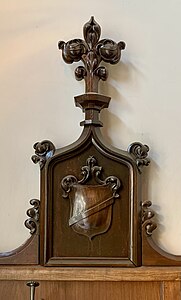Fleuron (architecture)
A fleuron is a flower-shaped ornament,[1] and in architecture may have a number of meanings:
- It is a collective noun for the ornamental termination at the ridge of a roof, such as a crop, finial or épi.
- It is also a form of stylised Late Gothic decoration in the form of a four-leafed square, often seen on crockets and cavetto mouldings.
- It can be the ornament in the middle of each concave face of a Corinthian abacus.
- Finally, it can be a form of anthemion, a Greek floral ornament.[2]
Gallery
- Ancient Greek fleuron as an anthemion (Greek word for flower), c. 350–325 BC, marble, Metropolitan Museum of Art, New York City
- Ancient Greek Corinthian capital with a fleuron on the abacus, from the tholos at Epidaurus, said to have been designed by Polyclitus the Younger, c.350 BC, stone, Archaeological Museum of Epidaurus, Greece[3]
- Ancient Greek fleuron as an anthemion on a mirror with cover, bronze, c.340 BC, bronze, National Archaeological Museum, Athens
- Roman Corinthian capital with a fleuron on the abacus of the Baths at Ostia, Ostia Antica, near modern Ostia, southwest of Rome, unknown architect, unknown date
- Roman Corinthian capital of the Temple of Vesta, Tivoli, Italy, with an oversized fleuron on the abacus, probably a stylized hibiscus blossom with spiral pistil, unknown architect, 1st century BC
- Gothic fleuron with a square section of a tier of four leaves or petals developing around a prominent central bud, early 13th century, illustration from the Dictionary of French architecture from the 11th to the 16th century by Eugène Viollet-le-Duc
- Gothic fleuron with two rays of foliage, mid-13th century, illustration from the Dictionary of French architecture from the 11th to the 16th century
- Gothic fleuron, 13th century, illustration from the Dictionary of French architecture from the 11th to the 16th century
- Gothic fleuron with stripped of foliage, 15th century, illustration from the Dictionary of French architecture from the 11th to the 16th century
- Gothic fleurons on a crown of the Virgin, c.1390-1395, terracotta with paint, Metropolitan Museum of Art
- Gothic fleuron on the Brussels Town Hall, Belgium, by Jean Bornoy, Jacob van Thienen or Jan van Ruysbroeck, 1401-1455
- Gothic fleurons in the Chapelle de Condat, Libourne, unknown architect, probably the 15th century and restored in the 1860s
- Neoclassical fleuron on the capital of a Corinthian pilaster of the Fontaines du Théâtre-Français, Paris, designed by Gabriel Davioud and sculpted by François Théophile Murgey,[4] 1867-1874
- Gothic Revival fleurons from the finials of Cologne Cathedral, Cologne, Germany, by Ernst Friedrich Zwirner, c.1880
- Gothic Revival reinterpretation of a fleuron on the College of Saint Teresa-Ganduxer, Barcelona, Spain, by Antoni Gaudí i Cornet and Joan Baptista Pons i Trabal, 1887-1889
- Oversized Neoclassical fleurons on the Romanian Atheneum, Bucharest, Romania, inspired by those of the Temple of Vesta in Tivoli, by Paul Louis Albert Galeron, 1888
- Gothic Revival fleuron in the George Severeanu Museum, Bucharest, unknown architect, c.1900
- Gothic Revival fleurons on the Grave of the Alexandru Costescu Family in the Bellu Cemetery, Bucharest, unknown architect, c.1900
- Typography fleurons
See also
References
- ^ "Fleuron" Oxford English Dictionary Second Edition on CD-ROM (v. 4.0) © Oxford University Press 2009
- ^ Curl, James Stevens (2006). A Dictionary of Architecture and Landscape Architecture (Second ed.). Oxford University Press. pp. 880 pages. ISBN 0-19-860678-8.
- ^ Hugh Honour, John Fleming (2009). A World History of Art - Revised Seventh Edition. Laurence King Publishing. p. 147. ISBN 978-1-85669-584-8.
- ^ Raguenet, R. Materials and Documents of Architecture and Sculpture. G. Broes Van Dort Co. p. 14 (section for capitals).


![Ancient Greek Corinthian capital with a fleuron on the abacus, from the tholos at Epidaurus, said to have been designed by Polyclitus the Younger, c.350 BC, stone, Archaeological Museum of Epidaurus, Greece[3]](https://upload.wikimedia.org/wikipedia/commons/thumb/6/6d/Corinthian_capital%2C_AM_of_Epidauros%2C_202545.jpg/451px-Corinthian_capital%2C_AM_of_Epidauros%2C_202545.jpg)










![Neoclassical fleuron on the capital of a Corinthian pilaster of the Fontaines du Théâtre-Français, Paris, designed by Gabriel Davioud and sculpted by François Théophile Murgey,[4] 1867-1874](https://upload.wikimedia.org/wikipedia/commons/thumb/d/d3/Fontaine_Nymphe_Fluviale_Paris_4_%28cropped%29.jpg/213px-Fontaine_Nymphe_Fluviale_Paris_4_%28cropped%29.jpg)





